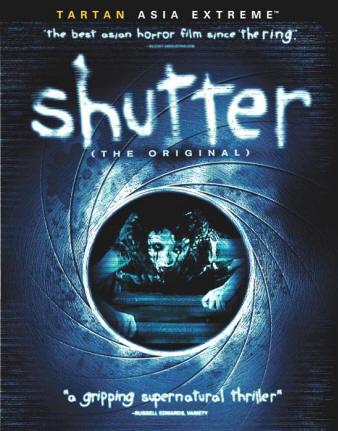INSIDE:
NEWS/STORIES/ARTICLES
Book Reviews
Columns/Opinion/Cartoon
Films
International
National
NW/Local
Recipes
Special A.C.E. Stories
Sports
Online Paper (PDF)
CLASSIFIED SECTION
Bids & Public Notices
NW Job Market
NW RESOURCE GUIDE
Archives
Consulates
Organizations
Scholarships
Special Sections
Upcoming
The Asian Reporter 19th Annual
Scholarship & Awards Banquet -
Thursday, April 20, 2017
Asian Reporter Info
Contact Us
Subscription Info. & Back
Issues
ASIA LINKS
Currency Exchange
Time Zones
More Asian Links
Copyright © 1990 - 2016
AR Home

Where EAST meets the Northwest
|
From The Asian Reporter, V18, #50 (December 16, 2008), page 13. Ghost in the machine Shutter Directed by Banjong Pisanthanakun and Parkpoom Wongpoom Produced by Yodphet Sudsawad DVD, 95 minutes By Mike Street Special to The Asian Reporter In Asian ghost stories of recent vintage, specters can haunt a variety of contemporary technologies, from the haunted videotape in Ringu to the deadly e-mails of Arang. And because they combine the familiar toys of modern society with the equally familiar frights of ancient legends, these movies are often remade in the U.S., where the fear of technology plays much better than the haunting. In the 2004 Thai thriller Shutter — recently remade by 20th Century Fox — the ghosts make themselves known through film. Interestingly, this hearkens back to spirit photography from the early days of cameras, where hucksters would use double exposures and other tricks to make it seem like they’d photographed a ghost. Modern technology means spirit photography is easier to fake, but the ghost in Shutter is no Photoshop trick, and its mysterious manifestations are a metaphor for the inescapability of even the best-buried parts of our past. Except for the mysterious specter, the action in Shutter centers almost entirely around Tun (Ananda Everingham), a freelance photographer, and his girlfriend Jane (Natthaweeranuch Thongmee). One night while driving home from a friend’s wedding, a tipsy and giggly Jane pays more attention to Tun than to the road and hits a girl wandering in the middle of the street. Panicked by an approaching car, Tun tells her to drive away before they can check on the girl, and the intimidated Jane obliges. When they return the next day, however, a worker at the scene says there was no body found, nor are there any unidentified bodies at local hospitals. The secret of what they’ve done bears heavily on them, as does the mystery of their disappearing victim. Soon afterward, Tun begins seeing strange smears in his photographs, some of which seem to resemble the face of a girl. Jane becomes obsessed with the smears of light and ghostly images and begins researching spirit photographs. She finds out the ghostly images (when they’re not faked) represent unfinished business — good or bad — that the dead have with the living. Initially assuming they are being haunted by their hit-and-run victim, Jane soon discovers the images in fact match a girl who died many years ago. As she digs deeper into the history of the girl, she is surprised to find how they’re connected and why they’re being haunted. Shutter was very successful in Thailand and won several international awards, which inevitably led to a tepid Hollywood remake earlier this year. As always, the American version lacks the cultural depth of the Asian original, making it ring hollow. The Thai original, for all its grittiness, resonates far more deeply, even with those unfamiliar with Eastern superstitions about ghosts. American ghosts tend to be motiveless malignancies living in haunted houses (as in The Shining, Poltergeist, or The Amityville Horror) or forests (Sleepy Hollow or The Blair Witch Project) harassing anyone who dares to enter rather than wreaking revenge on particular victims. As a result, American ghost stories often revolve around merely defeating the ghost or "getting out alive," with the ghost’s backstory revealed as an afterthought. In Asian cultures, ghosts tend to menace people rather than places, as vengeance for things that occurred when they were alive. The reason for the haunting is often crucial to defeating the ghost, which is why the Thai version of Shutter seems so much scarier. There are certainly many standard Asian horror moments in the Thai Shutter, but the film gets its most powerful frights from the central revelation we see toward the end of the film, as well as the haunting denouement of the final scene. Co-directors Pisanthanakun and Wongpoom do an excellent job of making the ending both surprising and inevitable, while Everingham and Thongmee carry this two-person cast extremely well. Western directors often err in remaking Asian horror films by merely appropriating the plotline without understanding the cultural underpinnings. It’s rare for any piece of culture to mean the same in East and West, which is why kabuki seems so odd to Americans, or why Japanese hip-hop seems sterile in a country that lacks a class of poor, troubled, racially segregated inner-city youth. The 2008 Shutter seems like a poorly translated version for this same reason, so check out the far superior original instead. Even if you’re not from Thailand, you can’t help but feel the deeper levels of fear plumbed by director and cast. And the next time there’s a strange smear of light on one of your pictures, you may start wondering if your hidden past is catching up to you, too. |

